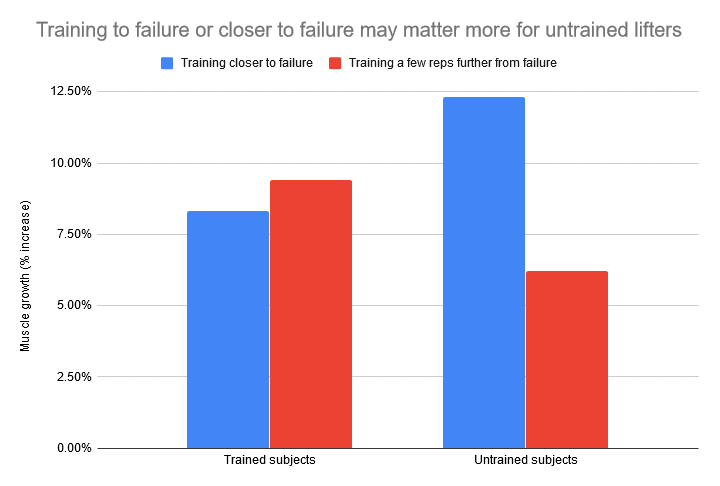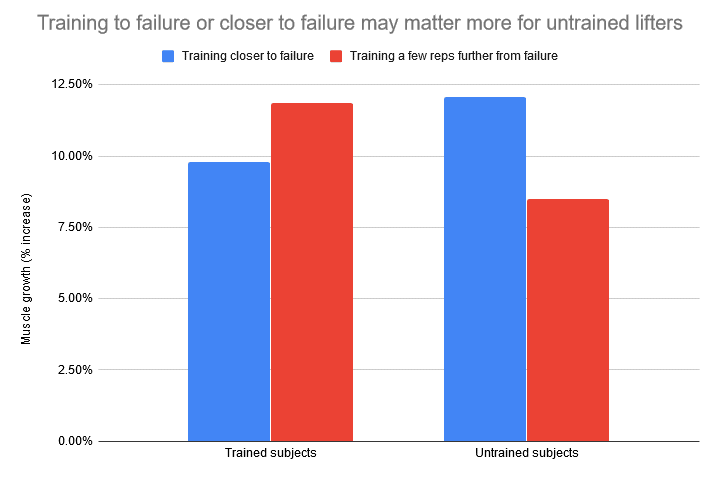A few years ago, I wrote an article titled “Can We Predict Muscle Growth?” It’s still a pretty good read, but if you don’t have the time or inclination to wade through two pretty long articles today, I’ll save you some effort. Here was the conclusion:
“At this point you may be saying, ‘Holy crap, dude. You’re basically saying that there’s no good way to predict how much I’ll grow from my training?’
To which I’d respond: Yep, pretty much.
Of the available tools, I personally think tracking the number of hard sets per muscle is the most useful, followed closely by relative volume, but all of them are pretty rough and have pretty big drawbacks.”
That didn’t sit well with some people because a lot of us (and I assume this disproportionately applies to people who are into science) like to quantify things in a way that we hope will yield predictive insights. When we set up a training program, we want to know what outcomes to expect given the quantifiable inputs that go into it. However, as you can tell, I didn’t think we were there yet back in 2016, at least in general. It’s not that we don’t have a rough idea of what will cause muscle growth; it’s just that we can’t predict that a particular change to a particular program will reliably cause a change in hypertrophy of x% on a group level. I think our current understanding is a bit like a map and a compass rather than turn-by-turn directions: It can point us in the right general direction, but not tell us exactly how to get from point A to point B.
Since 2016, however, an old idea has been revamped and risen to prominence: effective reps. I polled my audience on Instagram while writing this article, and 62% said they bought into the “effective reps” model (with over 2.5k votes), which tells me that it’s a pretty commonly-held belief, at least in my little corner of the internet (and that I should probably brace for some hate mail from this article). There are a few different iterations of this idea floating around, but the one that has gained the most traction seems to be Chris Beardsley’s (though Borge Fagerli, James Krieger [paywall] and Carl Juneau have written about it as well). In simple terms, the idea is that the last 5 reps before failure are “stimulatory reps” because they involve both full motor unit recruitment and slow contraction velocities. Now, I will note that Chris has actually written quite a lot about this idea, and his understanding of hypertrophy is more nuanced than “it’s the last 5 reps that matter, and nothing else.” However, as is often the case on the internet, it’s the simplistic version of the idea that’s gained significant purchase, and this is the specific article (or Instagram post) people share to support their point. That’s primarily what I’ll be attempting to rebut in this article, but I want to make it clear that I’m not trying to refute everything Chris has ever said on the topic, and I’m not attempting to conflate Chris’s actual beliefs with the simplified version of his beliefs that has gotten popular. I just want to make the point that the idea that the last 5 reps before failure are “effective reps,” and therefore the ones that REALLY matter for hypertrophy, doesn’t actually have all that much experimental support.
Just so you have an idea of where I plan for this article to go, here’s the rough layout:
- An overview of the mechanistic rationale and evidence underpinning the “effective reps” idea.
- A critique of the mechanistic rationale for “effective reps.”
- A re-examination of the evidence for “effective reps.”
- A thorough overview of studies where sets are matched, but different groups terminate each set at different proximities to failure.
- An additional look at studies that are informative, presented in a slightly less systematic fashion.
- To make sure this article is useful, I’ll end by trying to make sense of the evidence, and put forth a (hopefully better) model.
“Effective Reps” – An Overview of the Mechanistic Rationale
If I understand Chris’s rationale correctly, there are two primary reasons one should expect the last 5 reps before concentric failure to be the ones that really matter for hypertrophy:
- Around 5 reps from failure is approximately the point where full motor unit recruitment occurs.
- Near failure, when shortening velocities are low, each recruited fiber is experiencing more mechanical tension (force), and is thus receiving a larger stimulus to grow.
I’ve seen two different reasons put forth for why ~5 reps from failure is approximately when basically all motor units are recruited, and thus reps start “counting.” The first comes from classic isometric work (which is discussed in basically any introductory exercise physiology textbook), where motor unit recruitment increased up to approximately 85ish% of maximal voluntary contractile force, with rate coding (the rate at which each motor unit fires) accounting for further increases in force past that point. We also know that motor unit recruitment increases with fatigue as people approach failure. Since 85% of 1RM is approximately a 5RM load, it’s thus believed that you recruit basically all motor units from the very first rep when training with 5RM loads, or during the last 5 reps during a set to failure. The second reason I’ve seen put forth for why the last 5 reps are the ones that really matter comes from research showing that muscle EMG (electrical activity, which should be roughly associated with fiber recruitment and discharge rate) increases early in a set, and plateaus at a high level approximately 3-5 reps before failure.
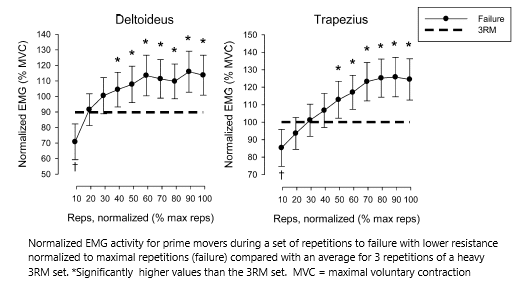
The reasoning behind the necessity of low shortening velocities relates to the well-known muscle force-velocity relationship. Muscle fibers can only generate low forces when concentrically contracting at high velocities, and can generate high forces when concentrically contracting at low velocities. The rate that actin-myosin cross-bridges can form is relatively low, while the rate they detach increases as contraction velocity increases. This means that at high contraction velocities, only a fraction of the possible actin-myosin cross-bridges can form, and thus tension on the individual muscle fiber is low; at low velocities, way more actin-myosin cross-bridges are active at any given point in time, and thus tension on the muscle fiber is much higher.
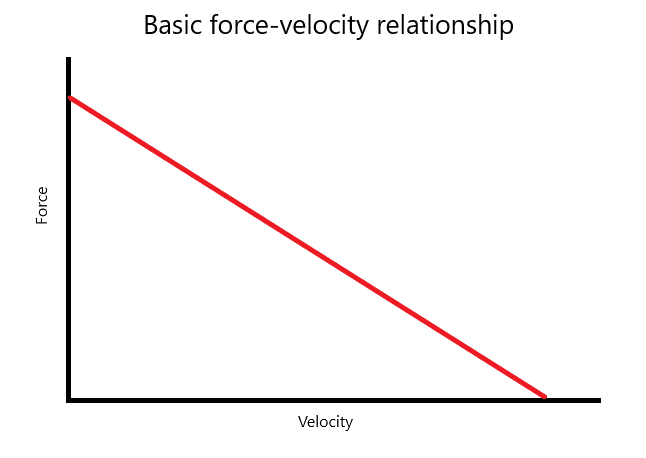
I’ll note that it’s incredibly reasonable for fiber recruitment and high tension on each fiber to be the two main things to care about when developing a model of hypertrophy. Mechanical tension seems to be the primary initiator of the cellular processes that lead to muscle growth, so the “effective reps” model is definitely prioritizing the right things.
“Effective Reps” – An Overview of the Evidence in Favor
The idea of “effective reps” helps explain the very well-documented finding that, when sets are taken to failure, the rep range you train in doesn’t affect muscle growth through a very wide array of rep ranges (from probably 5 or 6 reps per set on the low end, up to probably 30-40ish reps per set on the high end). If you’re doing at least 5 reps per set, and you’re going to failure on every set, you’re always getting in 5 “effective reps” per set, so each set is similarly effective for muscle growth regardless of the rep range you’re training in.
The “effective reps” model also makes sense of the supposition that per-set hypertrophy is lower when doing fewer than 5 reps per set (if there are fewer than 5 reps per set, there are necessarily fewer than 5 “effective reps” per set, so a set to failure with more reps has the potential for more effective reps if taken to failure). The “effective reps” model also makes sense of the supposition that longer rest periods are beneficial for hypertrophy; when fatigue accumulates, it can inhibit motor unit recruitment and force output, reducing tension on the fibers you’re trying to train (effectively decreasing the number of “effective reps” during a set to failure).
So, thus far, the “effective reps” model is looking pretty good. It seems to have a strong theoretical rationale, and it makes sense of several important findings.
A Critique of the Mechanistic Underpinnings for “Effective Reps”
The contrarian in me wants to argue against the assumption that a fiber has to be recruited in order to grow. We know that tension-sensitive mechanisms are largely responsible for initiating hypertrophy, but we also know that a substantial amount of tension can be “felt” by fibers that aren’t recruited via the production of force that’s transmitted laterally from recruited fibers into the matrix of connective tissue that runs through the muscle. And, since it’s difficult to study individual fibers or motor units, I don’t think we know for sure that a fiber does have to be recruited in order to grow. However, I’m not quite that much of a contrarian, so I’ll assent that it’s a perfectly fair assumption that fibers need to be recruited, at least to maximize growth.
I am somewhat skeptical, however, about whether we need to get up to ~85% 1RM or within ~5 reps of failure to reach essentially full motor unit recruitment, at least in a particular context that a lot of serious lifters would care about: when considering the prime movers of multi-joint exercises.
While we do tend to see that EMG increases as load increases during single-joint training, and we do tend to see that EMG increases as contraction intensity increases during isometric training, it’s not always that simple with multi-joint exercises.
For example, in a recent study by van den Tillaar and colleagues, EMG of the quad muscles barely changed as load increased from 50% to 90% of 1RM in the squat when subjects were instructed to lift explosively. A prior study by McBride et al had similar findings: similar vastus lateralis EMG in the squat with 70% and 90% 1RM loads. A study by Król and Golaś also found that pec EMG in the concentric phase of the bench press was basically unaffected by increasing loads from 70% to 100% of 1RM.
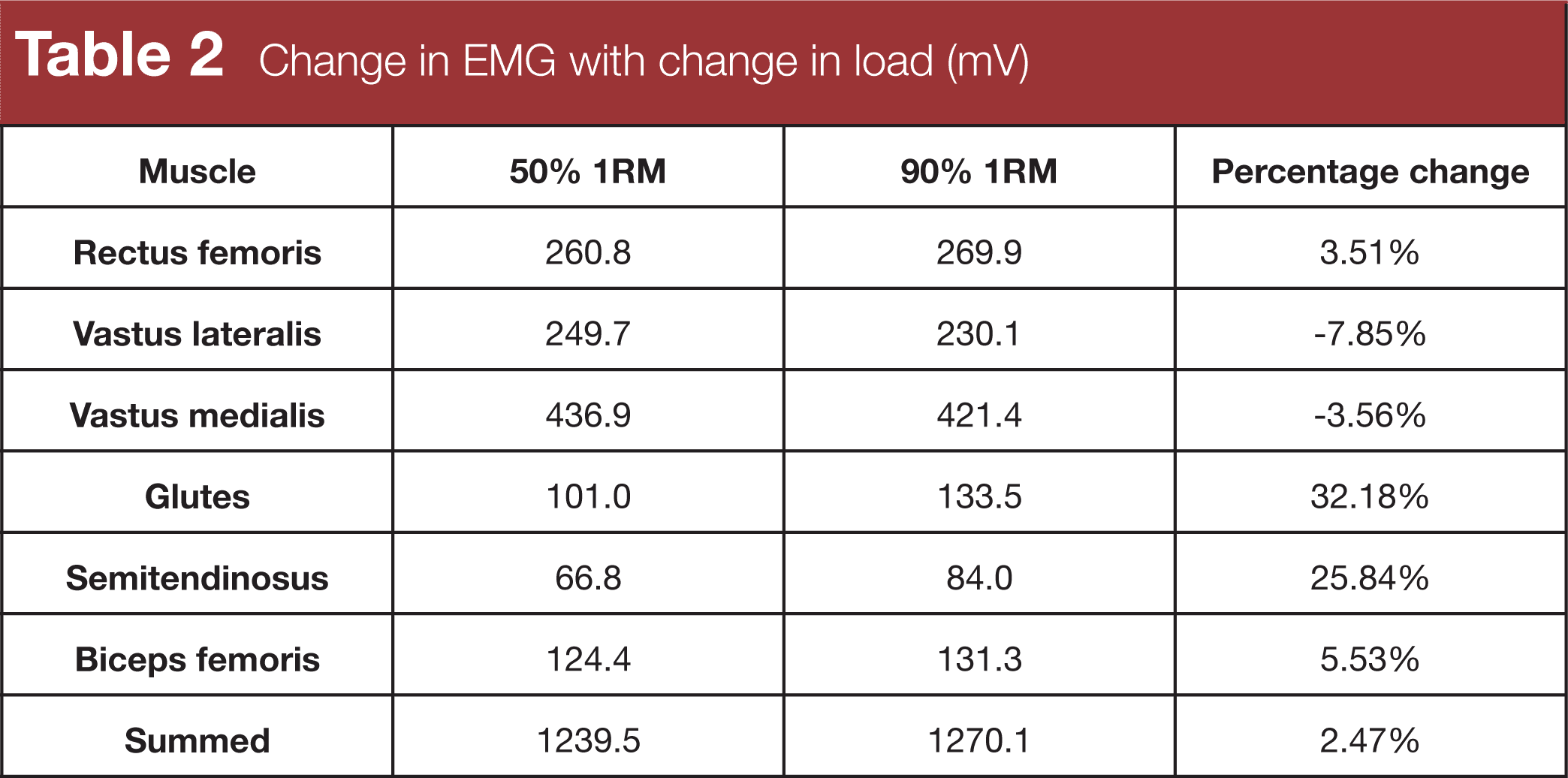
However, in all three of these studies, the EMG activity of secondary muscles (hip extensors in van den Tillaar, hamstrings in McBride, and triceps and front delts in Król and Golaś) did increase as load increased. Notably, all three of these studies used trained lifters. Thus, it’s possible that for trained lifters performing multi-joint exercises, they’re able to recruit virtually all motor units for the primary muscle trained by a multi-joint exercise with substantially lower loads and pretty far away from failure, with activation of secondary muscles ramping up as load increases or as they approach failure. So, if you’re benching for triceps growth or squatting for glute growth, you may need to go pretty close to failure to recruit most motor units, but if you’re benching for pec growth or squatting for quad growth, you may be recruiting the vast majority of your motor units from rep 1, even with moderate (i.e. 70% 1RM, or 12RM) loads.
I’m also skeptical of the claim that the slow contraction speeds during the last five reps prior to failure are indicative of greater tension on the recruited fibers.
While the force-velocity relationship of muscle (higher forces at lower velocities) is true and very well-supported, it’s important to remember the contexts in which it was established: isolated muscle fibers contracting one time at different velocities, and dynamic movements performed once (or a very small number of times) at different velocities.
However, you’ll notice that those contexts differ substantially from a set of reps with a given load taken to failure; the research establishing the force-velocity relationship was performed on muscles or fibers that were unfatigued. Fatigue changes things.
To illustrate, here’s pilot data from someone who helped me out when I was refining my protocol for my thesis project (this data was chosen at random; everyone’s data looks basically exactly like this, though).
With loads increasing from 30% to 100% of this person’s max, force output increases basically linearly, while velocity decreases basically linearly.
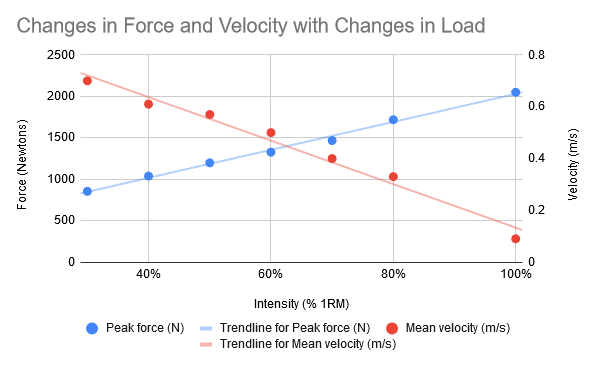
However, during a single set to failure with 75% of 1RM, force output and velocity both decrease as this individual approaches failure.
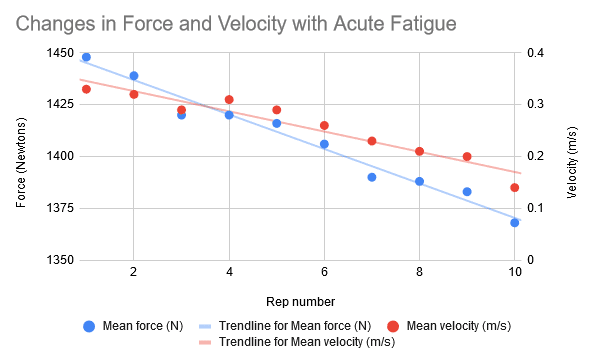
Here’s the disconnect: when you’re changing loads and moving every load as explosively as possible, you see a decrease in velocity along with increases in force. With the same load, however, a decrease in velocity also means a decrease in force. Unless I’m missing something obvious, I don’t see why this same principle wouldn’t also apply to individual muscle fibers. As an unfatigued fiber contracts against increasing forces, velocity will also decrease. However, as a fiber fatigues, the tension it can produce also decreases. Moreover, central mechanisms can decrease the motor unit’s firing rate, meaning that even if a given fiber could keep producing as much force if maximally stimulated, it still won’t be able to in vivo because signals from its motor nerve won’t reach it at the same frequency.
This concept is illustrated in a 2017 paper by Potvin and Fuglevand. As I understand it, it’s generally accepted as the best motor unit-based model of muscle fatigue we have, incorporating a considerable amount of mechanistic evidence and producing predictions that match up well with experimental results.
The meat of the paper models the effects of holding isometric contractions of 20%, 50%, and 80% of maximal voluntary contraction force until failure, as well as the effects of sustaining a maximal contraction for 200 seconds (presented below, in that order).
There’s a lot going on in the following graphics, but here are some landmarks to pay attention to:
- The motor unit labeled “100” is pretty near the top of the high threshold motor units, while the motor unit labeled “120” is the highest threshold motor unit, and thus the last one recruited.
- The left side of the graphs looking at the effects of the sustained maximal contraction give you a reference point for each motor unit’s maximal firing rate (top right graph) and force output (bottom left graph)
- The bottom left graph (MU force) is probably the most important for each of these groups. It shows the amount of force each motor unit would actually be producing at each point in time.
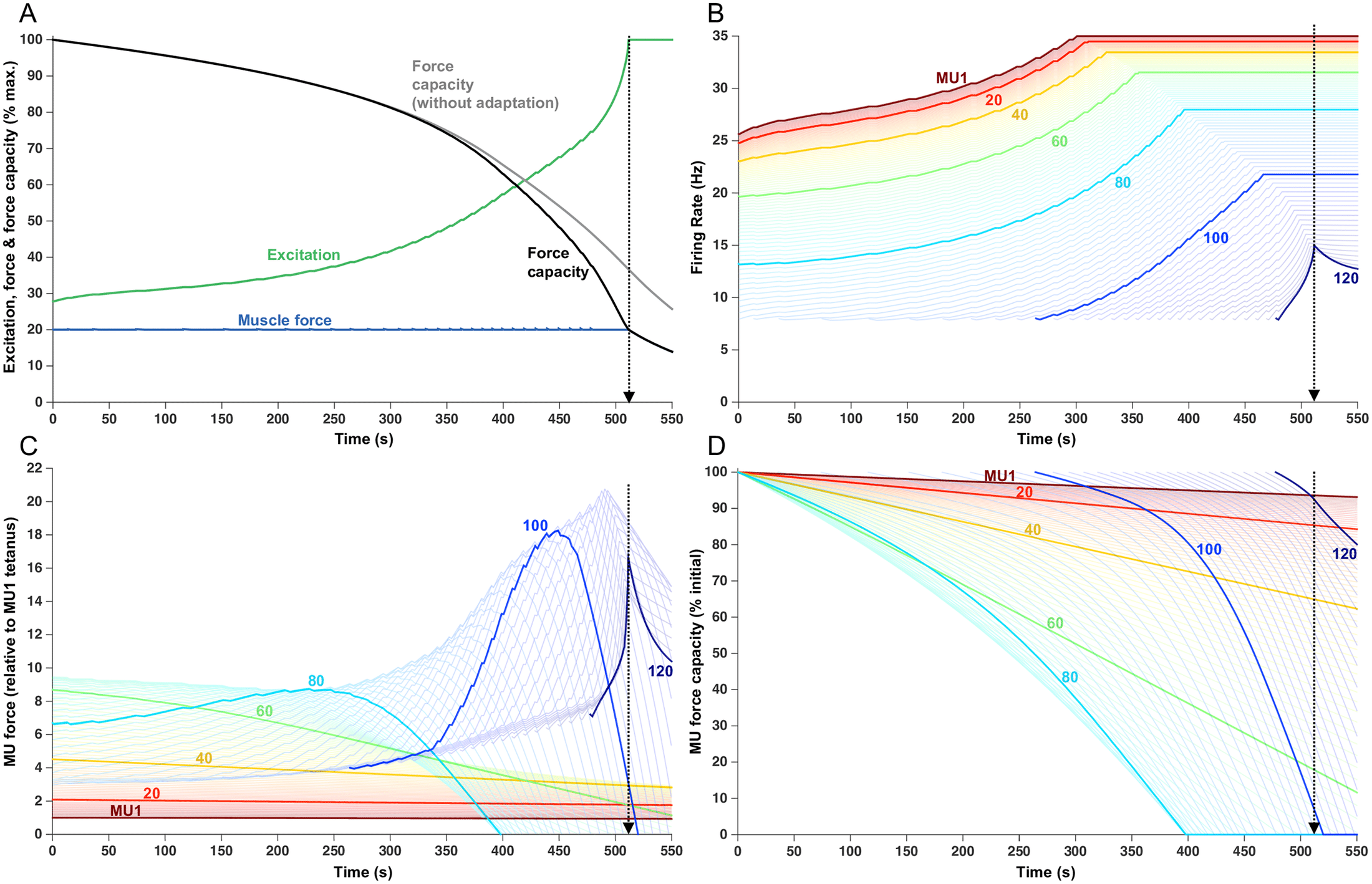
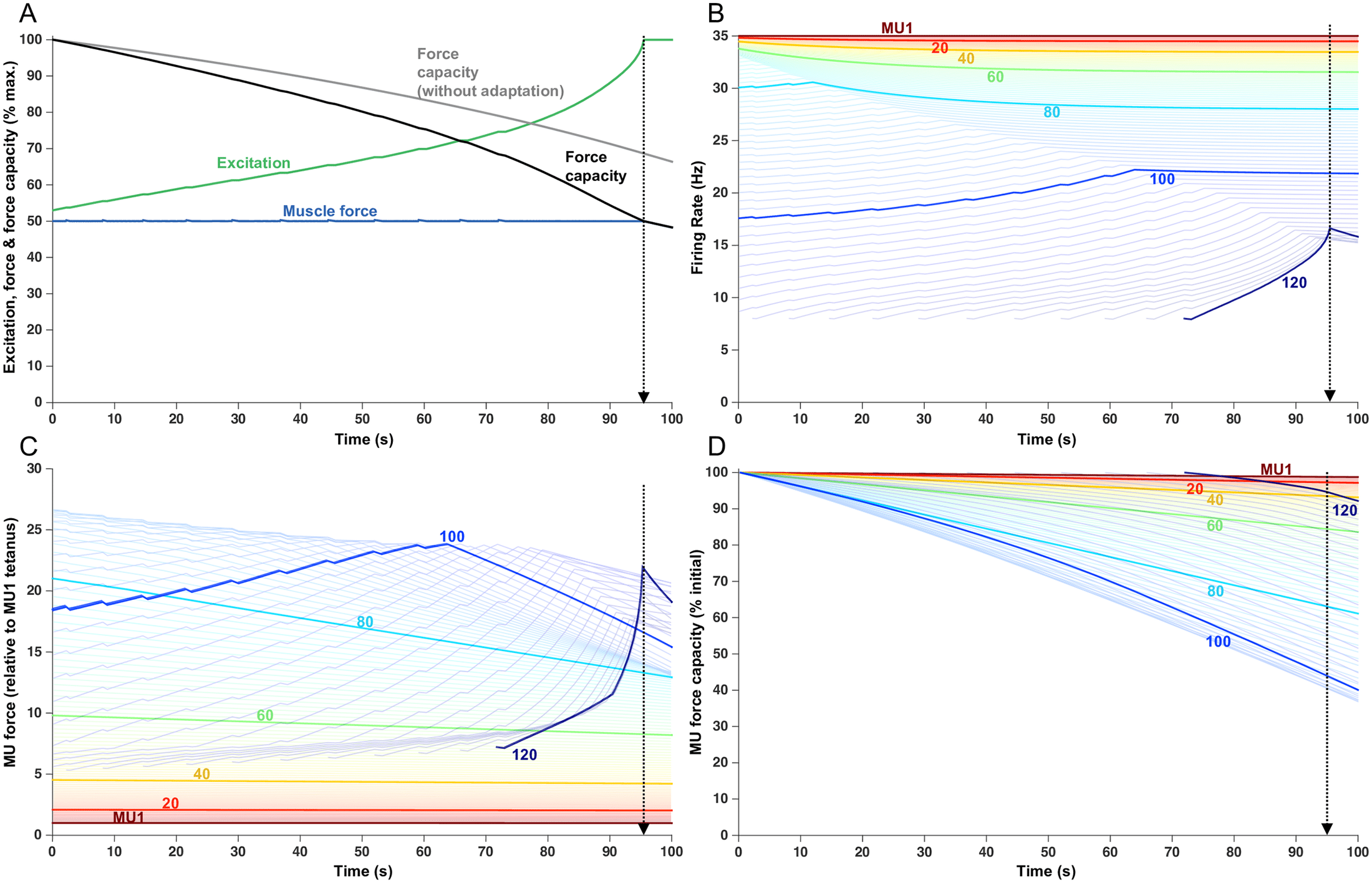
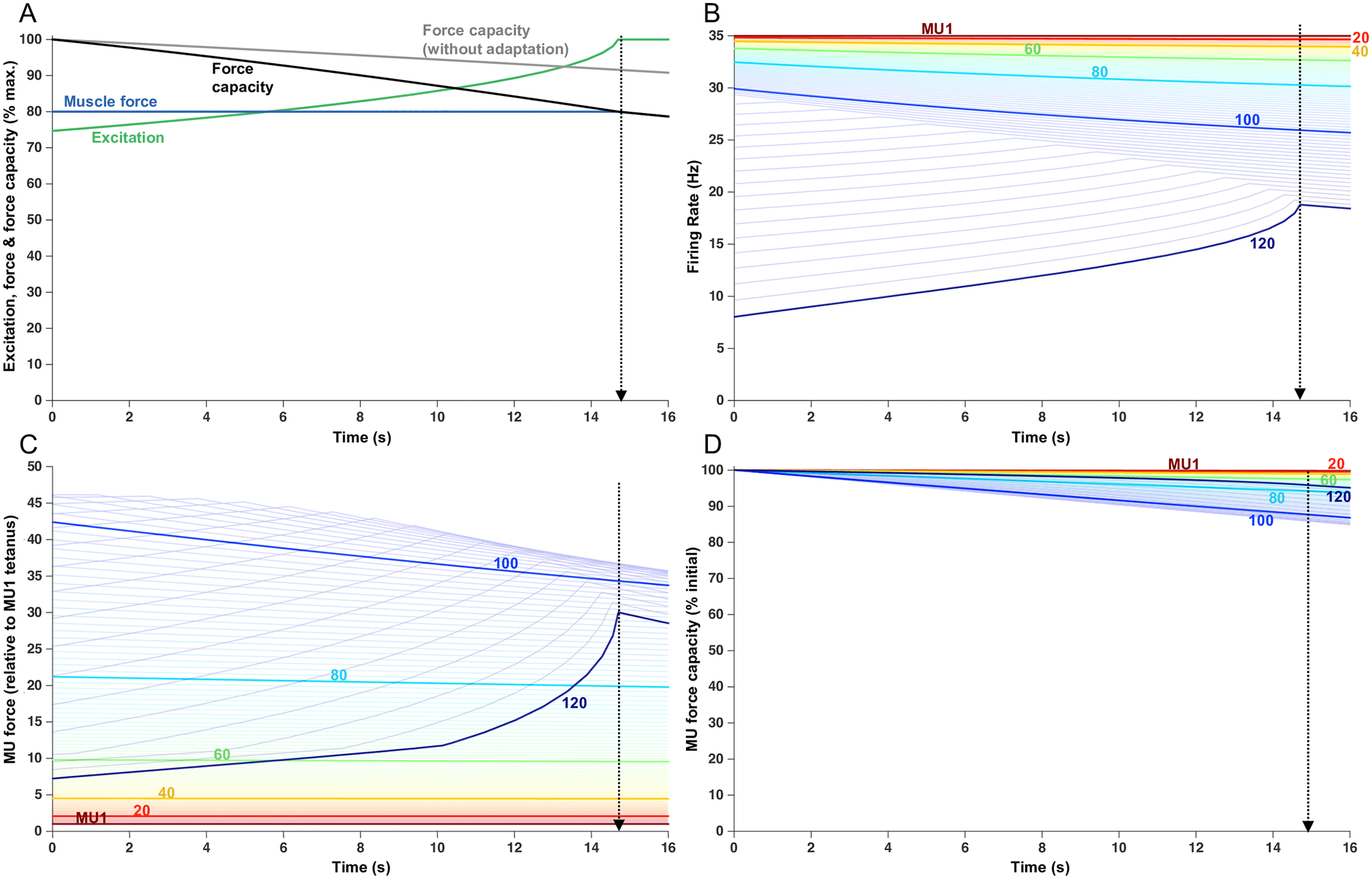
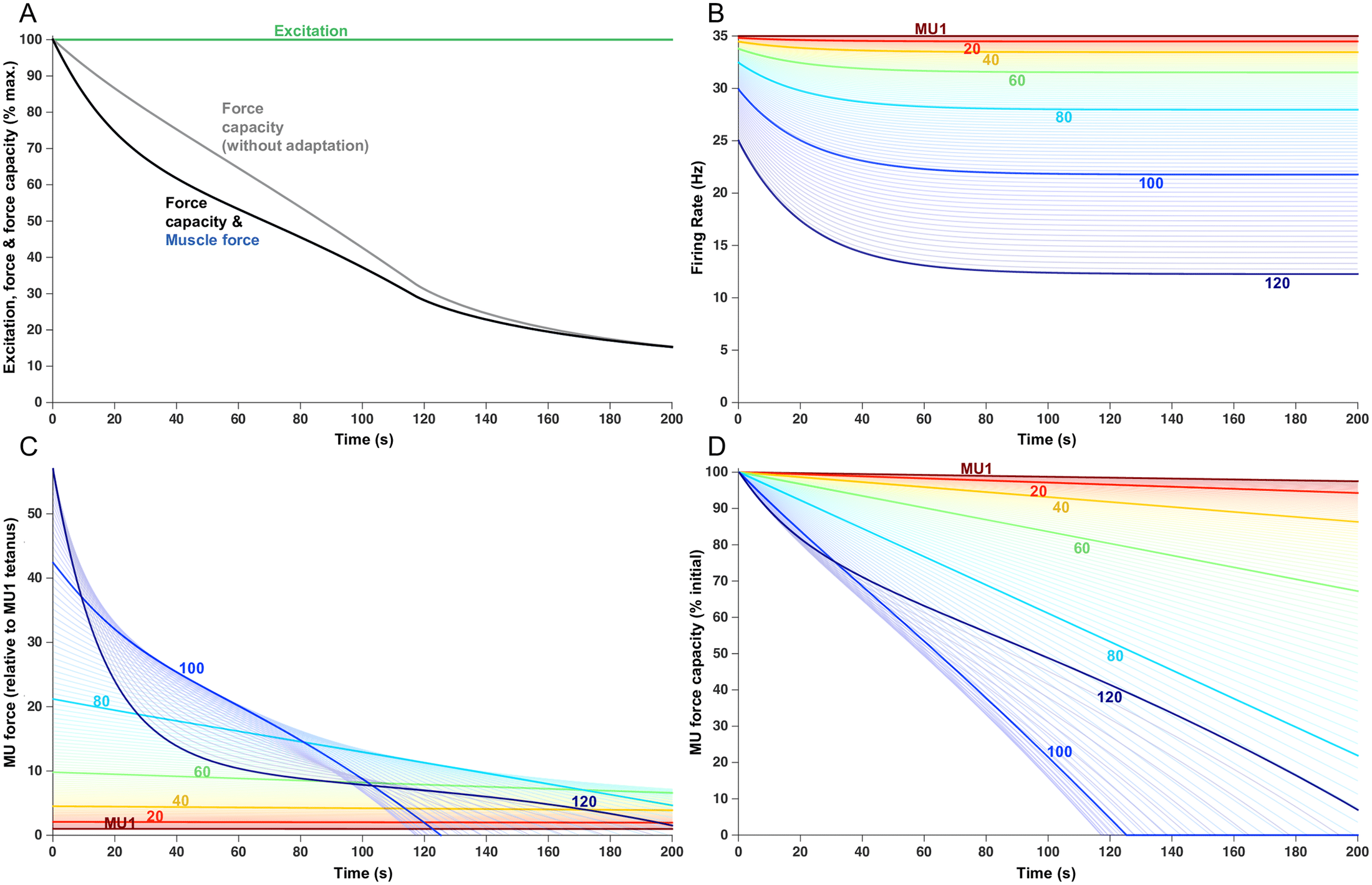
I told you there was a lot going on in these graphics, so let’s break this down:
- At the start of a maximal contraction, the force produced by MU 100 is approximately 42x greater than the tetanic force of MU 1, and the force produced by MU 120 is almost 60x greater than the tetanic force of MU 1. You can think of those values as the maximal tension the fibers associated with those MUs can be exposed to. Similarly, the maximal firing rate is about 30Hz for MU 100, and about 25Hz for MU 120.
- During a 50% sustained contraction, MU 100 and MU 120 wind up with peak contractile forces a bit less than 25x the tetanic force of MU 1. During an 80% sustained contraction, MU 100 starts at a contractile force of approximately 42x greater than the tetanic force of MU 1, with force output decreasing over time. MU 120 is recruited from the very start of the contraction, but its initial force output and firing rate are both very low, with force output eventually ramping up to approximately 32x the tetanic force of MU 1.
- In other words, MU 100 only reaches about 2/3 of its maximal force output during a 50% contraction, while MU 120 doesn’t even reach 1/2 of its maximal force output. During an 80% contraction, MU 100 does attain maximal force output, and it does so early in the contraction (not near the point of failure), while MU 120 still only reaches slightly more than 1/2 of its maximal force output.
Now, dynamic contractions clearly aren’t identical to isometric contractions. However, I still think this is a useful model, and due to the effects of fatigue on motor unit firing rates and force capacity, a few things seem likely:
1) Your very highest threshold motor units probably don’t simultaneously get recruited and reach maximal firing rates (and thus maximal force output/tension) unless force output is very close to maximal: not 80%, but 100% or very close to it.
2) With lower-to-moderate loads (i.e. 50% 1RM), a hefty chunk of your higher threshold motor units (not just your very highest threshold motor units) do get recruited, but probably don’t get particularly close to reaching maximal force/tension.
3) With higher loads (i.e. 80% 1RM or 8RM loads), a lot of your high-threshold motor units probably attain maximal tension pretty early in a set before fatigue starts setting in, and are actually producing considerably less force in the few reps before failure.
Finally, there’s a pretty clear conflict between Potvin’s model, “effective reps,” and longitudinal evidence. If a fiber needs to be recruited and exposed to near-maximal tension in order to grow, you’d expect lower loads (i.e. 50% of 1RM) to be dramatically worse for muscle growth than higher loads (i.e. 80% of 1RM) on a per-set basis, since basically all of the high threshold motor units are recruited lower loads, but are likely only exposed to a fraction of their maximal force output, even when a set is taken to failure. However, the longitudinal research indicates that heavier and lighter training lead to similar increases in both whole-muscle hypertrophy and fiber-type specific hypertrophy. This conflict could be resolved in one of two different ways: 1) Potvin’s model is wrong, or is so specific to isometric contractions that it’s completely irrelevant for dynamic contractions (I do think it’s likely that the picture is messier with dynamic contractions, but the physiology the model is based on – specifically how motor unit behavior changes with fatigue – is basic and sound, so I doubt things are fundamentally different) or 2) the “maximal tension” assumption of the “effective reps” model is faulty, because it both assumes an incorrect interpretation of the force-velocity relationship, and because it doesn’t adequately account for the ways fatigue affects motor unit behavior.
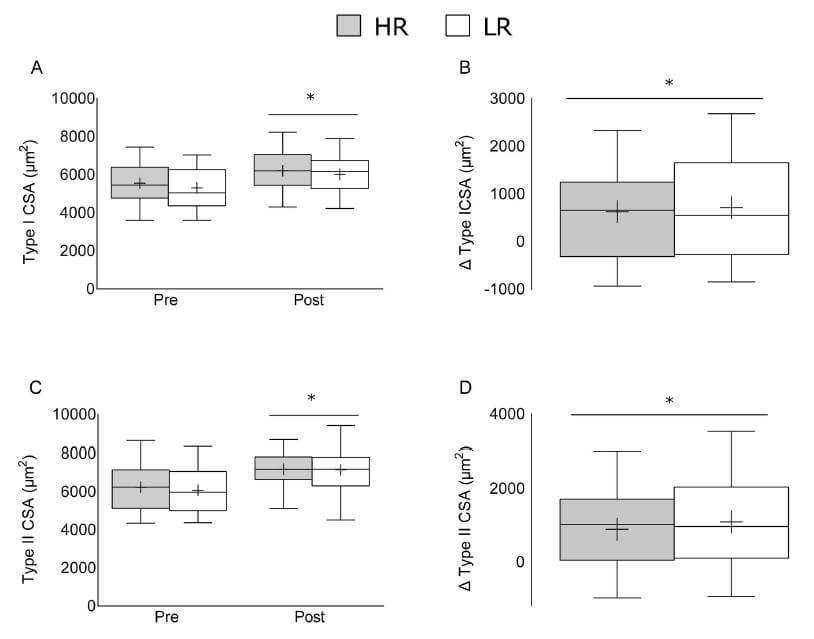
So, to sum up this section, I think the relationship between external load and motor unit recruitment is more complex for multi-joint exercises than the “effective reps” model accounts for (such that basically full motor unit recruitment may occur at lower loads and further from failure than would be suggested based on isometric and single-joint research), and the assumption that fibers need to be exposed to maximal tension in order to grow seems to conflict with model-based research, longitudinal research, or both.
A Re-examination of Experimental Evidence
For this section, I want to start by focusing on the research that’s the most directly relevant for evaluating the predictive power of the “effective reps” model: research with at least one direct measure of hypertrophy where either total sets or total reps are pretty closely equated, but two groups or conditions train at different proximities from failure during “normal” training (i.e. not doing cluster sets or drop sets or anything fancy that just introduces additional variables).
By my count, there are eight relevant studies. They’ll be graphically summarized below if you just want to scroll until you see a multi-colored bar graph. I’d recommend reading this section, but it’s pretty long and dry (just summarizing each of these eight studies), so I wouldn’t hold it against you if you skipped it.
Impact of Two High-Volume Set Configuration Workouts on Resistance Training Outcomes in Recreationally Trained Men. Karsten et al. (2019).
Subjects: 18 young men with between 2 and 5 years of training experience.
Protocol: 6 weeks of training twice per week, with a frequency of once per muscle group per week. One group did 4 sets of 10 reps to failure for all exercises (with ~75% of 1RM), while the other group did 8 sets of 5 reps with similar relative loads (i.e. ~75% of 1RM), thus staying far from failure. The direct measures of hypertrophy were vastus medialis thickness, elbow flexor thickness, and anterior deltoid thickness. Of note, the subjects only did one exercise that directly targeted the quads (squats; they also did deadlifts, though deadlifts probably don’t cause much quad hypertrophy), but they did four exercises that directly or indirectly trained the biceps (barbell curls, DB curls, underhand grip rows, and pull-downs), and four exercises that directly or indirectly trained the front delts (bench press, chest press, shoulder press, and front delt raises).
Results: Vastus medialis thickness increased significantly more (p = 0.026) in the group doing 4x10RM (5.92% vs. 0.63%), but increases in elbow flexor thickness and anterior delt thickness were similar between groups (8.6% vs. 5.08% and 8.03% vs. 11.65% for the 4x10RM and the 8×5 groups, respectively).
RPE vs. Percentage 1RM Loading in Periodized Programs Matched for Sets and Repetitions. Helms et al. (2018)
Subjects: 21 men with at least two years of training experience, a 1RM squat of at least 1.5x bodyweight, and a 1RM bench of at least 1.25x bodyweight.
Protocol: 8 weeks of training with a squat and bench press frequency of 3x/week. One group trained using pre-defined percentages, and the other group did the same sets and reps with loading based on target RPE ranges. The RPE group ended up training ~1-3 reps closer to failure through most of the study.
Results: There were no significant differences between group’s increases in pec thickness or vastus lateralis thickness at two different sites (5.61% vs. 6.21%; 7.53% vs. 6.96%; and 9.92% vs. 9.66% in the percentage and RPE groups, respectively).
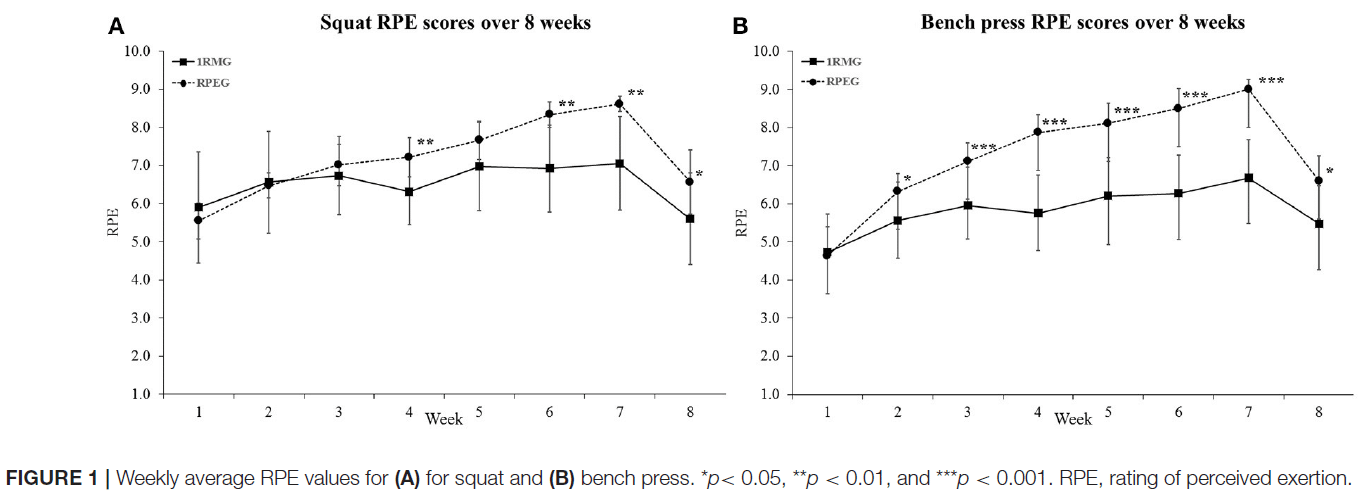
Is Repetition Failure Critical for the Development of Muscle Hypertrophy and Strength? Sampson et al. (2015)
Subjects: 28 untrained men
Protocol: Following a 4-week familiarization phase, subjects were randomized into three groups doing 4 sets of curls 3 times per week for 12 weeks. Two groups did sets of 4 (one group did fast eccentrics and 2-second eccentrics, while one group did fast eccentrics and concentrics), and one group performed all sets to failure. All groups started at 85% 1RM, and loads were adjusted each week based on performance. The two non-failure groups also performed one set to failure per week to gauge progress, and also to more-or-less match volume load with the failure group.
Results: The two non-failure groups averaged about 2 fewer reps per set than the failure group (4.2 vs. 6.1). However, gains in elbow flexor cross-sectional area were similar between group (10.9% and 7.1% for the two non-failure groups, and 11.6% for the failure group).
The Impact of Metabolic Stress on Hormonal Responses and Muscular Adaptations. Goto et al. (2005)
Subjects: 18 untrained men
Protocol: The subjects trained twice per week for 12 weeks doing knee extensions (they also did shoulder press and pull-downs, but there weren’t any assessments of hypertrophy relevant to those exercises). One group did 5 sets of 10 reps; the first set was performed with 75% of a 10RM load, and load was adjusted from there to allow for 10 reps per set. The other group followed the same protocol, except that they rested for 30 seconds between the 5th and 6th rep of each set, effectively making each set two mini-sets and (presumably) keeping the subjects further from failure.
Results: Increases in quad cross-sectional area were larger in the group doing traditional sets than the group employing an intra-set rest (12.9% vs. 4.0%).
Effects of Velocity Loss During Resistance Training on Athletic Performance, Strength Gains, and Muscle Adaptations. Pareja-Blanco et al. (2016)
Subjects: 24 young men with 1.5-4 years of training experience
Protocol: Subjects trained twice per week for 8 weeks doing 3 sets of Smith machine squats in both sessions. Over the course of the study, training loads increased from ~70% 1RM to ~85% 1RM. One group terminated each set after their concentric velocity within the set decreased by 40%, while another group terminated each set after their concentric velocity within the set decreased by 20%. As a result, the group training with a velocity loss of 40% reached failure on 56.3% of their sets, whereas the group training with a velocity loss of 20% never reached failure. There were also large differences in the total number of reps performed (~67% more in the 40% velocity loss group), and in the number of reps performed at relatively slow velocities (<0.5m/s; ~90 in the 40% velocity loss group vs. ~10 in the 20% velocity loss group).
Results: Total muscle volume of the quads increased in both groups; while results leaned in favor of the 40% velocity loss group, the difference wasn’t statistically significant (7.7% vs. 4.6%). Mean fiber cross-sectional area of the vastus lateralis also increased in both groups, without significant differences between groups (10.19% vs. 8.69% in the 40% and 20% loss groups, respectively). Interestingly, the mean fiber area of the IIx fibers (presumably the highest threshold motor units, though we need to be cautious as fiber typing was done via staining) increased non-significantly more in the 20% loss group (17.51% vs. 11.82%), which would seem to run counter to the supposition that you need to train very close to failure to maximally stimulate the highest threshold motor units.
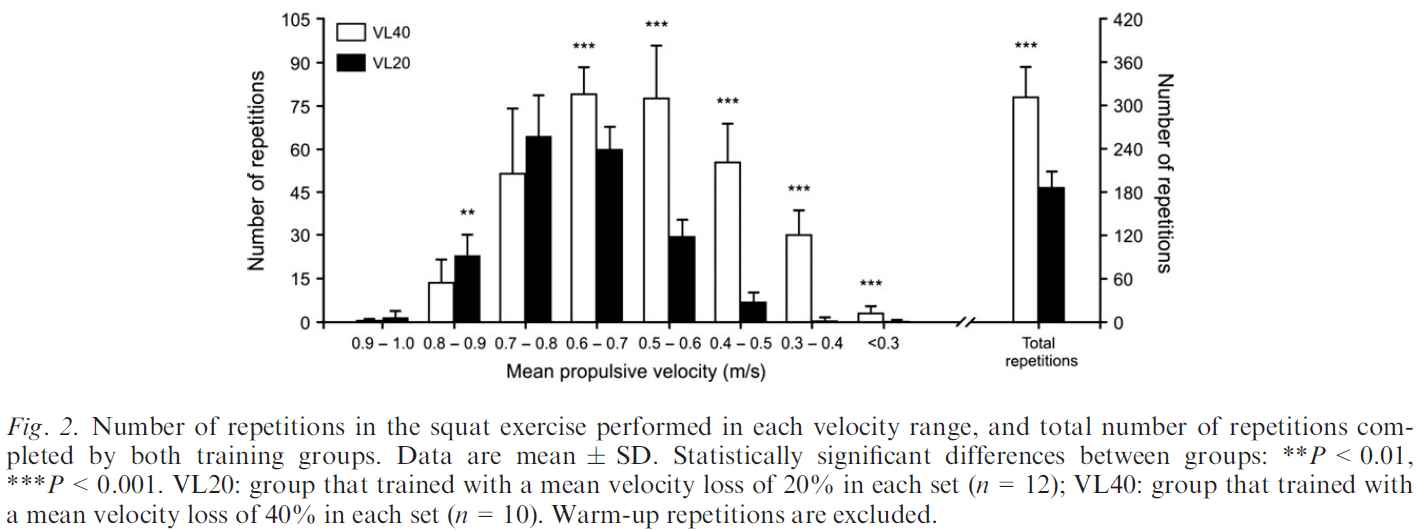
Strength Training with Repetitions to Failure Does Not Provide Additional Strength and Muscle Hypertrophy Gains in Young Women. Martorelli et al. (2017)
Subjects: 89 untrained young women
Protocol: The subjects did curls twice per week for 10 weeks. One group did 3 sets to failure with 70% of 1RM, one group 3 sets of 7 with 70% of 1RM, and one group did 4 sets of 7 with 70% of 1RM in an effort to match volume load with the group training to failure.
Results: The group training to failure increased biceps muscle thickness by 17.5%, the group doing 4 sets of 7 increased biceps muscle thickness by 8.5%, and the group doing 3 sets of 7 increased biceps muscle thickness by just 2.1%. The authors didn’t run the correct statistical tests to determine whether those gains were significantly different, but it’s highly likely that there were significant differences between all groups unless the variance in the training response within each group was astronomically high.
Effects of Resistance Training to Muscle Failure vs. Volitional Interruption at High- and Low-Intensities on Muscle Mass and Strength. Nóbrega et al. (2017)
Subjects: 27 untrained young men
Protocol: This study used a within-subject unilateral design, meaning that for each participant, one leg was assigned to one protocol, and their other leg was assigned to another protocol. Subjects performed unilateral knee extensions with either a high load (80% of 1RM) to a low load (30% of 1RM), stopping each set either at failure (actually missing a rep) or “volitional interruption” (which, as best I can tell, meant stopping each set when they thought they couldn’t do another rep, but before they actually failed). Training took place twice per week for 12 weeks, and the subjects performed three sets per leg per workout.
Results: Vastus lateralis cross-sectional area increased similarly in all four conditions (6.9% high load to failure, 7.1% high load to volitional interruption, 7.5% low load to failure, 6.1% low load to volitional interruption).
Skeletal Muscle Fiber Adaptations Following Resistance Training Using Repetition Maximums or Relative Intensity. Carroll et al. (2019)
Subjects: 15 men with an average of 7.7 years of training experience
Protocol: Subjects trained three times per week for 10 weeks. One group trained using relative intensities, and one group trained using rep maxes. The relative intensity group based their training on a percentage of their set and rep best in theory (so, for example, if you could do 3 sets of 10 reps with 100kg, a relative intensity of 85% would mean doing 3 sets of 10 at 85kg), but they effectively trained using reps in reserve, stopping sets 2-6 reps shy of failure two days per week, and staying even further from failure (4-10 reps shy of failure) on the third day of each week. The rep max group used loads where their last set of each exercise reached failure. They also did sprint training two days per week. Over the course of the study, the subjects did some clean pulls and a few step-ups, but the bulk of the quad work they did (which is where hypertrophy was assessed) was just three sets of squats on the first and third training day of each week.
Results: All hypertrophy measures were taken from the vastus lateralis. The relative intensity group had a significantly larger increase in anatomical cross-sectional area (8.77% vs. 3.24%). All other measures leaned in favor of the relative intensity group, but the differences weren’t statistically significant (13.52% vs. 7.00% for type I fiber CSA; 24.00% vs. 12.49% for type II fiber CSA; 23.58% vs. 14.11% for muscle thickness). 1 I could have potentially included this study by Giessing et al., but determined that not enough of the variables were adequately equated. For example, the groups trained with different intensities, and a couple of the groups did slightly different exercises. It’s also slightly less relevant for most trainees because the groups only did one set of each exercise)
So, let’s step back and get a lay of the land. There are two studies where training to failure or closer to failure produced clearly superior gains compared to stopping further from failure (Goto and Martorelli). There’s also a single measure in another study where training to failure seemed to be superior (vastus lateralis hypertrophy in the Karsten study; elbow flexor and anterior deltoid hypertrophy were similar between groups in the same study). There’s also one study where stopping further from failure was clearly superior (Carroll). So, out of a total of 18 measures across 8 studies, the group doing more “effective reps” – often way more “effective reps” – experienced significantly more growth just three times (and experienced significantly less growth once). That doesn’t strike me as particularly strong experimental support. If we just take a simple average of all of these measures, we come up with an 8.9% increase in muscle size when staying further from failure, and a 9.2% increase in size when going to failure or closer to failure. If we pool the results of each study before averaging (so studies with more measures don’t get undue weight), it’s 7.8% vs. 10.3%. That does perhaps seem to slightly lean in favor of greater growth when going closer to failure, but when many of these studies compare programs with multi-fold differences in “effective reps,” but growth is still fairly comparable, it certainly seems to put the concept of “effective reps” on very shaky footing.
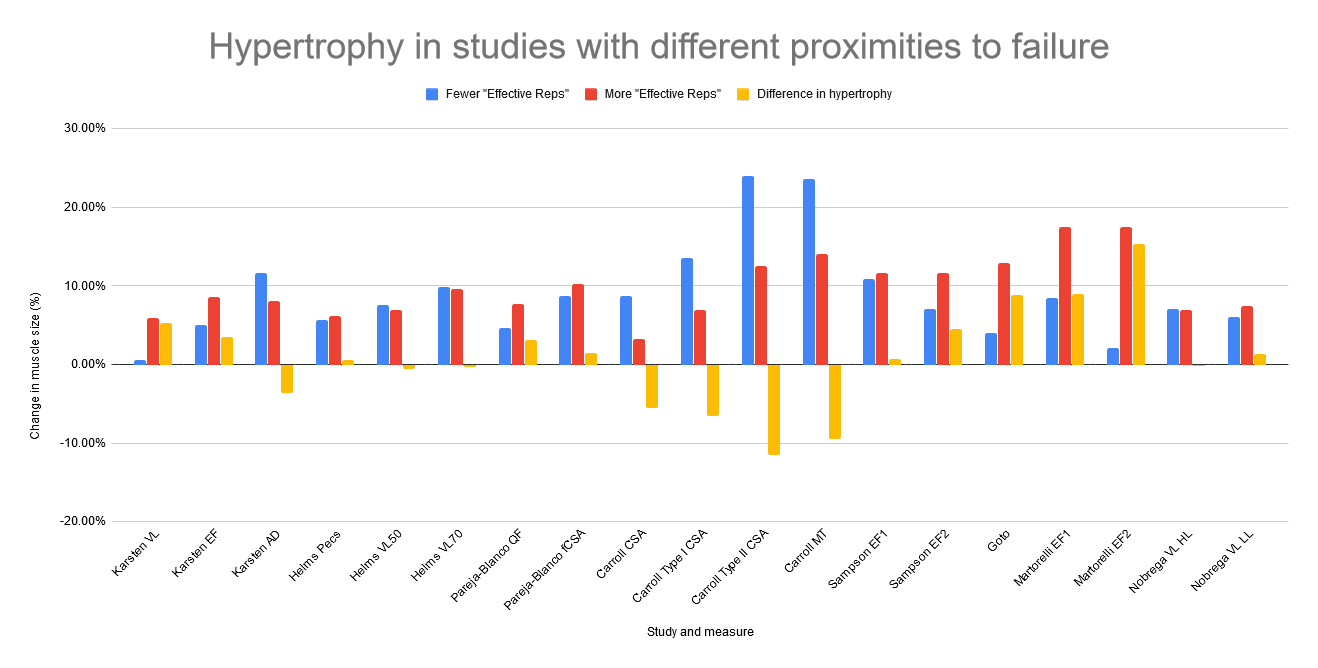
If we drill down into the details of these studies, an interesting pattern emerges. There are four studies on trained lifters (Karsten, Helms, Pareja-Blanco, and Carroll) and four studies on untrained lifters (Sampson, Goto, Martorelli, and Nóbrega). All four studies on trained lifters used mostly multi-joint exercises, and all four studies on untrained lifters used single-joint exercises. In the studies on trained lifters using multi-joint exercises, there’s no real difference between going closer to failure or staying further from failure: a 9.5% increase staying further from failure versus a 8.3% difference going closer to failure. However, in the studies on untrained lifters using single-joint exercises, things lean hard in favor of going to failure or closer to failure, with the groups going closer to failure experiencing almost twice as much growth on average: 12.3% vs. 6.2%. This finding will be discussed more later on.
While we’re at it, I also want to address two of the other suppositions I previously alluded to that “effective reps” are supposed to help explain.
The first supposition is that low rep training (<5 reps per set) doesn’t build muscle as effectively on a per-set basis as moderate rep training.
We really only have three studies directly comparing low rep and moderate rep training where sets are equated. The one everyone cites is this paper by Schoenfeld et al., comparing the effects of training at 2-4RM loads versus 8-12RM loads with sets equated. It pretty clearly shows more hypertrophy of the quads (large between-group effect size; 0.84) when training with 8-12RM loads, but the between-group effect sizes for elbow flexor and elbow extensor hypertrophy were both trivial (g = 0.14 and 0.04). A similar study by Mangine et al., however, compared the effects of training at 3-5RM loads versus 10-12RM with sets equated, and found significantly greater gains in arm lean mass, along with a bunch of other non-significant differences. Digging back a little further, Weiss et al. compared the effects of training at 3-5RM loads versus 11-13RM loads, and found no significant differences in either quad or hamstrings hypertrophy. And if you don’t mind sparing 3-5RM training an extra set, Campos et al. didn’t find significant differences in quad hypertrophy when comparing training with 4×3-5RM versus 3×9-11RM. So, I guess it’s possible that shifting down by one rep from 3-5RM loads to 2-4RM loads makes all the difference in the world (or that 3-5RM actually means exactly 5RM, so the subjects can get in all 5 of their effective reps per set), but I just don’t think we can claim with a tremendous amount of confidence that low rep training is worse for growth on a per-set basis. I strongly suspect that heavy singles and doubles aren’t ideal for growth, but how about sets of 3 or 4? I sort of suspect that the bottom end of the “hypertrophy range” extends a bit lower than 5 or 6 reps per set.
The second supposition is that short rest intervals lead to less growth, because central fatigue limits motor unit recruitment, and thus the amount of “effective reps” you can do per set. Again, everyone cites this study by Schoenfeld et al. as evidence that short rest intervals decrease hypertrophy (another study by Buresch and colleagues had similar findings). However, this study by Villaneueva et al. in older men found that shorter rest intervals enhanced gains in lean body mass, and this study by Fink et al. found that doing curls for sets of 20 with a 30-second rest interval basically doubled biceps growth compared to doing sets of 8 with a 3-minute rest interval (which is notable because, all else being equal, sets of 8 and sets of 20 should be similarly effective for hypertrophy). This study by Fink et al. also failed to find significant differences between 30-second and 150-second rest intervals.
To wrap up this section, if the direct experimental evidence for “effective reps” is murky at best (and relies almost entirely on studies utilizing untrained lifters doing single-joint training), and if two of the other findings that “effective reps” are supposed to explain are actually on pretty shaky footing in their own right, I’m left wondering what, exactly, the “effective reps” model does for us in the first place.
General Ramblings about Hypertrophy
Let me take a step back for a moment, and admit I may have been a tad too harsh in the previous section. In fact, I hope I was. The thing that bothers me the most about how I’m seeing people discuss “effective reps” is that many people aren’t acting like it’s a rough model, but rather, they’re discussing it as if it’s a proven fact. Chris and others have made the case for “effective reps” at length and quite compellingly, so I wanted to present a somewhat aggressive case against it. I don’t expect everyone who’s bought into the model to throw it out on the spot, but I do hope that they’ll consider some of my points, temper their enthusiasm a bit, and hopefully approach the subject with a bit more circumspection and nuance.
Hopefully now I can add a bit to the discussion, and not just take the coward’s route of criticizing other peoples’ ideas without putting some of my own out into the world.
For starters, I think there’s a pretty large kernel of truth to the general idea of “effective reps.” I think the “hard” version of the idea (“the last 5 reps before failure are all the matters”) has major problems, but a “soft” version of the idea is almost self-evidently true. To maximize hypertrophy on a per-set basis, you do almost certainly have to get somewhat close to failure, in basically any context I can think of. If you can do 12 reps with a certain weight, doing 3 sets of 10 is almost guaranteed to get you more growth than doing 3 sets of 3.
I also think the “effective reps” model works quite well when dealing with single-joint exercises, and especially exercises where the most difficult part isn’t the stretched position. I absolutely agree that tension is the primary factor in play, but I’m not so confident that the tension generated by individual fibers is all that matters. Since the proteins that kick off the hypertrophy cascade are located around the adhesion points between muscle fibers and the surrounding matrix of connective tissue, tension of the connective tissue matrix pulling on the fiber should have a similar effect as tension on the fiber pulling on the connective tissue matrix 2 There’s actually some evidence for this. A recent study in mice found that tension on the muscle itself, rather than active contractile tension, was what triggered hypertrophic signalling (by comparing stretch versus eccentric contractions). There’s also evidence for stretch-induced hypertrophy in humans, in a study where steps were taken to ensure there was no active muscular contraction. . That’s especially relevant when you’re dealing with an exercise like a bench press where, for instance, passive tension from stretching the pecs and active tension from contracting the pecs are both high at the bottom of a rep, creating additive tension that all fibers will “feel.” However, in an exercise like a knee extension or a biceps curl, the hardest part of the lift doesn’t coincide with a stretched position for the target muscle. In that case, you are relying almost entirely on active tension. I think it’s entirely plausible that you do need to take a standard biceps curl to failure to maximize growth, and that you’re basically wasting your time from a hypertrophy perspective if you’re more than a handful of reps from failure, but I also think it’s entirely plausible that you don’t have to take a squat or bench press as close to failure to get a robust growth response. It should be noted that of the two studies on single-joint training that didn’t find more growth when going closer to failure, one (Sampson) did still include one weekly set to failure in the non-failure groups, and the other (Nóbrega) basically had all conditions go to failure (since the “voluntary interruption” conditions just meant stopping just before you actually failed a rep). In the two remaining studies on single-joint training where there was a large, persistent difference in proximity to failure (Goto and Martorelli), going to failure caused more than three times as much growth.
I’m also skeptical that maximizing per-fiber tension is all that important. My hunch is that the relationship between fiber tension and hypertrophy is somewhat logarithmic, with a plateau at a reasonably high (but not maximal) level of tension. We frequently see that the fibers associated with high threshold motor units grow just fine in response to training, but I’m skeptical that highest threshold MUs ever reach maximal tension unless you’re doing maximal isometrics or a true 1RM attempt (again, referring to the Potvin model from earlier). We also see that type II fibers seem to respond about as well to low-load training as high-load training, and I’m quite confident that, while the highest threshold MUs are recruited when going to failure during low-load training, they never reach anything approaching maximal tension. So, I do think that MU recruitment is an important factor to consider for growth, but I think that the growth-promoting effects of mechanical tension can be realized with per-fiber tensions that don’t necessarily need to approach maximal tension; otherwise, we’d be leaving a ton of growth for our highest threshold MUs on the table by neglecting maximal isometrics, which I don’t find particularly likely.
I also think people have written off metabolic stress a bit prematurely when scheming up hypertrophy models. Although the mechanisms by which mechanical tension lead to growth are better-characterized, that doesn’t mean there aren’t direct avenues for metabolic stress to promote hypertrophy that we just haven’t fully fleshed out yet. For example, this study has been rolling around in my brain; it found that “constant tension” training for the triceps caused more growth than training through a longer range of motion, potentially due to greater muscle deoxygenation (it found pretty strong correlations between hypertrophy and pre- and post-training muscle deoxygenation caused by the workouts). In a similar vein, this study found that training in hypoxic conditions led to more hypertrophy than training under conditions of normal oxygen exposure. We also recently saw the first evidence that lactate can directly trigger the pathway that initiates muscle protein synthesis in vivo (albeit in mice). A recent study by Morton et al. also found that hypertrophic signalling was associated with the change (reduction) in glycogen levels resulting from training. I’m also struck by the couple of studies that have found pretty large increases in hypertrophy with the addition of a single lighter set (one, two); I’m not sure how a purely tension-based accounting of hypertrophy can accommodate those findings. Regardless of the exact mechanism, a predictive model for hypertrophy seems like it needs some sort of fatigue term in it. Since the ability to generate tension decreases set-to-set, some aspect or byproduct of fatigue seems like it must contribute to hypertrophy; otherwise, I’m not sure how you could account for the very robust finding that multiple sets of resistance exercise cause more growth than single sets.
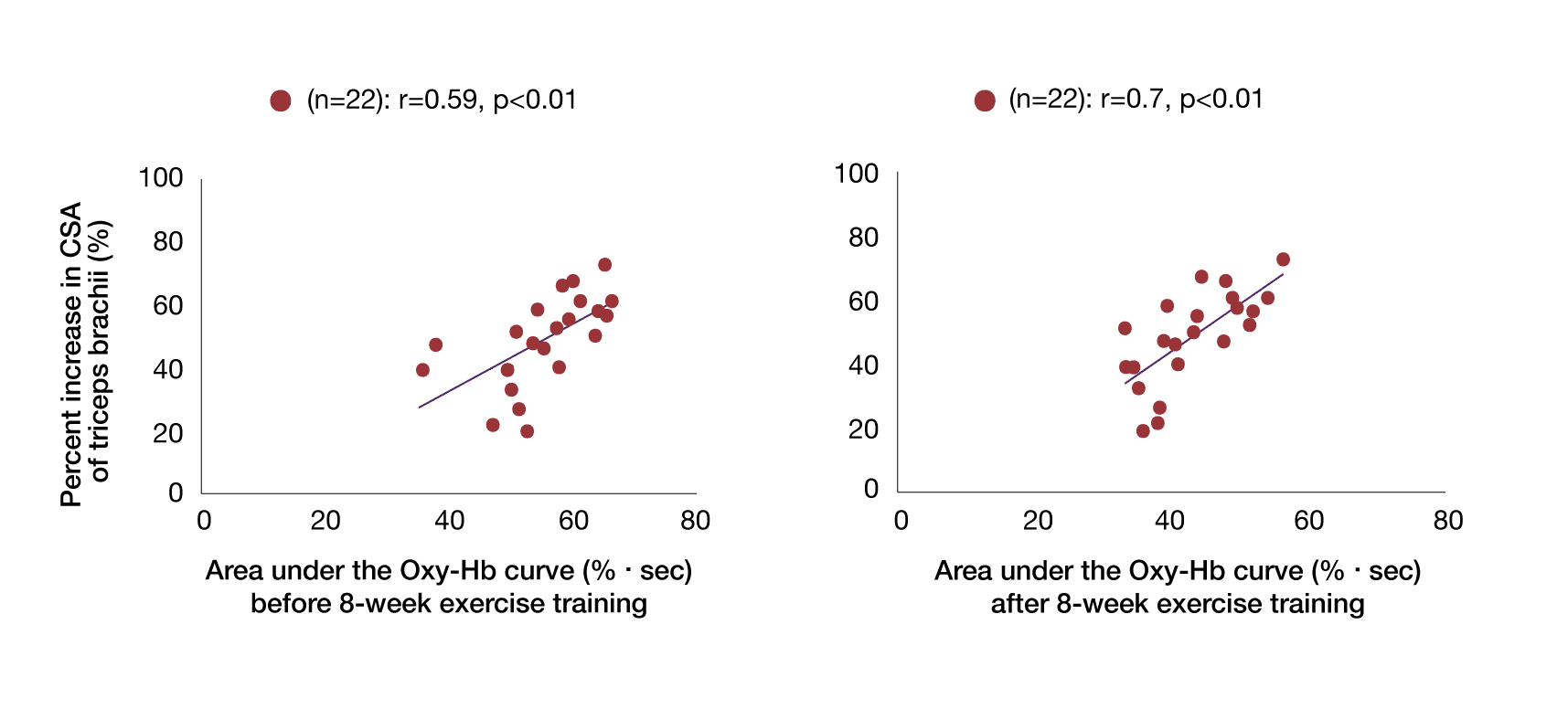
One thing that irks me a bit about the current literature on the effects of proximity to failure is that we can’t separate out the effects of training status from the effects of multi-joint versus single-joint training. My hunch is that training status matters, though. I don’t think well-trained lifters need to go as close to failure as untrained lifters in order to maximize the hypertrophic stimulus of a set. One adaptation to heavy resistance training is that synchronous recruitment of motor units improves. In other words, from the first rep of a set, you can “switch on” more motor units. Due to improvements in synchronous recruitment, I think it’s likely that trained lifters can reach the point of essentially full motor unit recruitment earlier in a set than untrained lifters do, (especially when trying to lift explosively). Furthermore, I think trained lifters can induce more metabolic fatigue on a per-rep basis than untrained lifters when training at the same percentage of their max. Energy demands of training scale with work rate, so if you double the weight on the bar, you roughly double the energy demands. However, mitochondrial density generally doesn’t increase with resistance training (though mitochondrial function may improve a bit), nor does capillary density (measured as capillaries per unit of muscle cross-sectional area, though there’s sometimes an increase in capillaries per fiber). So, energy demands go up, but the ability to meet those demands aerobically doesn’t change too much (certainly not at the same rate that strength increases), meaning the anaerobic contributions to energy expenditure increase, promoting greater metabolic fatigue on a per-rep or per-set basis. Thus, a model of hypertrophy with both a tension term and a fatigue term would predict that more highly trained lifters wouldn’t need to go quite as close to failure to accrue the necessary tension and fatigue to cause hypertrophy.
So, if I had to propose a model, I think tension is the initiator of hypertrophy, and some aspect of fatigue amplifies that signal (maybe it’s just lactate, maybe it’s some other protein or molecule produced under fatiguing conditions that senses deoxygenation or glycogen depletion, or maybe it’s something else entirely). I also think both of these factors have pretty reasonable thresholds, such that more tension promotes more hypertrophy up to a certain level, but you don’t need maximal tension on each fiber to maximize hypertrophy, and that more fatigue promotes more hypertrophy up to a certain level, but you don’t need maximal fatigue to maximize hypertrophy 3 This would make sense of the finding that intensity can be too low to maximize hypertrophy, and the decent body of literature (one, two, three) finding that hypertrophy seems to plateau after pretty moderate per-session volumes. Once tension is high enough and you induce enough fatigue, adding more tension or fatigue doesn’t do much for you. Both tension and fatigue working synergistically would explain why heavy singles or doubles probably don’t cause much growth: if the “important” fatigue is at all metabolic in nature, you’d be hard-pressed to induce it with super low rep sets. . However, I think the details of how those factors play out in training depends on context. Are you dealing with trained lifters (who will be able to recruit motor units and generate tension more efficiently) or untrained lifters (who will have a harder time generating tension)? Are you dealing with an exercise where the muscles are maximally challenged in a stretched position, or an exercise where virtually all of the tension comes from active contraction? Are you dealing with a single joint exercise where you may need to go pretty close to failure to get close to full MU recruitment of the muscle you’re trying to train, or a multi-joint exercise where your target muscle may get close to full recruitment further from failure? I don’t think this idea is fundamentally different from “effective reps.” On the contrary, getting within 5 reps of failure does ensure that tension will be quite high, and doing a fair amount of reps during a training session that are pretty close to failure is bound to generate quite a bit of fatigue. However, as I hope is clear by now, the “hard” version of effective reps (only worrying about reps that occur within 5 reps of failure) misses out on a fair bit of nuance, and doesn’t track that well with the experimental evidence.

Proposed model of hypertrophy. Thick arrow = causal relationship. Thin arrow = influence or enhancement. Within this model, there is assumed to be threshold for both tension and fatigue/metabolic stress at which hypertrophy is maximized, but neither maximal tension nor maximal fatigue/metabolic stress are assumed to be necessary to maximize hypertrophy.
As a final note to wrap things up, I want to reiterate that I’m not trying to call Chris out, or anything of that nature. As I mentioned, his ideas about hypertrophy are quite thorough and well-researched with a considerable amount of depth, and I’d highly recommend you check out his stuff. I mostly just wanted to critique the overly simplified version of his “effective reps” idea that the internet hivemind has latched onto. And again, I want to make clear that I’m not trying to imply that the “hard,” simplified version of his “effective reps” model is the entirety of what he actually believes about hypertrophy. Several of his articles are linked below; most of these discuss effective reps, but he has a lot of great stuff on his Medium profile and website.
- What is training volume?
- What causes muscle growth?
- Mechanical loading and *not* motor unit recruitment is the key to muscle growth
- What does training to failure actually achieve?
- How does training volume differ between training to failure, avoiding failure, and using advanced techniques?
- Does metabolic stress cause muscle growth?
- What determines mechanical tension during strength training?
- Do short rest periods help or hinder muscle growth?
- How does training volume affect muscle growth?
- How many stimulating reps are there in each set to failure?
Addendum, July 2020
Since this article was published, six more studies have come out that are worth discussing. Three are studies on untrained lifters, and three are on lifters with at least some prior training experience.
Trained lifters
Velocity Loss as a Critical Variable Determining the Adaptations to Strength Training. Pareja-Blanco et al. (2020)
In this study, trained men were split into 4 groups and trained the squat for 8 weeks. All groups performed the same number of sets, but reps per set were dictated using velocity loss thresholds. The thresholds were 0% (e.g. sets of just 1 rep), 10%, 20%, and 40%. The group training with a 40% velocity loss for each set therefore performed way more reps than any other group, and also performed far more reps that were close to failure.
However, the group training with a 20% velocity loss actually experienced (non-significantly) more quad hypertrophy than the group training with a 40% velocity loss (7% vs. 5.3%). The groups that stopped each set WAY far from failure (0% and 10% velocity loss) experienced less quad growth (2.2% and 2.1%, respectively).
Effect of resistance training to muscle failure vs non-failure on strength, hypertrophy and muscle architecture in trained individuals. Santanielo et al. (2020)
In this study, trained men’s legs were split into two conditions, and performed unilateral leg press and unilateral knee extensions for 10 weeks, using a within-subject design. In one condition, one leg trained to failure on every set, and for the other condition, subjects were instructed to “voluntarily interrupt” their sets shy of failure. Subjects performed the same number of sets with both legs, averaging 12 reps per set in the failure condition and 10.6 reps per set in the voluntary interruption condition.
Hypertrophy didn’t differ significantly between groups, but tended to be greater in the voluntary interruption condition. Vastus lateralis CSA increased by 13.5% when training to failure, and 18.1% when stopping all sets shy of failure.
Effects of velocity loss in the bench press exercise on strength gains, neuromuscular adaptations and muscle hypertrophy. Pareja-Blanco et al. (2020)
The design of this study was virtually identical to the other recent Pareja-Blanco study, except that the subjects were training the bench press instead of the squat, pec growth was assessed instead of quad growth, and the velocity loss thresholds were 0%, 15%, 25%, and 50% instead of 0%, 10%, 20%, and 40%.
Much like the other Pareja-Blanco study, the group training closest to failure (50% velocity loss) didn’t grow quite as much as the group stopping a bit further from failure (25% velocity loss), though the difference wasn’t significant: 20.3% vs. 16.5%. Furthermore, the two groups stopping even further from failure (0% and 15% velocity loss) did not experience as much growth: 8.7% and 11.8%. Honestly, I’m a bit surprised that the 0% velocity loss group experienced any hypertrophy at all.
Untrained lifters
Is Performing Repetitions to Failure Less Important Than Volume for Muscle Hypertrophy and Strength? Lacerda et al. (2020)
Untrained subjects trained for 14 weeks, performing knee extensions using a within-subject unilateral design. One leg performed 3-4 sets to failure, and the other leg matched the training volume for the failure leg, while performing an equal number of reps per set. The failure leg ended up performing all sets to failure (by design), while the non-failure leg typically had about 2 reps in reserve on the first set, 1 reps in reserve on the second set, and 0 reps in reserve (e.g. they didn’t fail, but they wouldn’t have been able to perform another rep) on the 3rd/4th set.
There weren’t significant differences between groups, but the leg that didn’t train to failure for the first 2 sets tended to grow more than the failure leg. Rectus femoris CSA increased by 20.11% in the non-failure condition versus 15.89% in the failure condition, and vastus lateralis CSA increased by 21.3% in the non-failure condition versus 15.06% in the failure condition.
Muscle Failure Promotes Greater Muscle Hypertrophy in Low-Load but Not in High-Load Resistance Training. Lasevicius et al. (2019)
This study compared 2 groups, split into 4 conditions, over 8 weeks of training. One group trained unilateral knee extensions with 80% of 1RM, and one group trained unilateral knee extensions with 30% of 1RM. Within each group, there was a failure and a non-failure condition. The failure leg performed 3 sets to failure in every workout, and the non-failure leg performed sets of 60% as many reps as the failure leg, until volume load was matched between legs (in other words, the non-failure leg performed approximately 5 sets). In the 80% group, the failure leg averaged 12.4 reps per set while the non-failure leg averaged 6.7, and in the 30% group, the failure leg averaged 34.4 reps per set while the non-failure leg averaged 19.6.
Quad growth was comparable in both conditions for the group training at 80% of 1RM (8.1% in the failure condition and 7.7% in the non-failure condition). However, quad growth was considerably greater in the 30% leg that trained to failure (7.8% for the failure leg vs. 2.8% for the non-failure leg).
Low-Load Resistance Training to Volitional Failure Induces Muscle Hypertrophy Similar to Volume-Matched, Velocity Fatigue. Terada et al. (2020)
In this study, untrained lifters trained the bench press for 8 weeks. Subjects were split into 3 groups. One group trained with 40% of 1RM for 3 sets to failure in each workout, one group trained with 40% of 1RM for 3 sets dictated by velocity (non-failure), and one group trained with 80% of 1RM for 3 sets that were basically to failure. For the 40% non-failure group, subjects completed reps until their velocity dipped 20% below the average velocity of their first 10 reps. They didn’t train to failure, but I think they got fairly close to it. They averaged 34.1 reps on their first set, 21.1 reps on their second set, and 16.9 reps on their 3rd set, compared to 40.4, 19.1, and 15.3 in the failure group. For the 80% group, the text of the study says they were supposed to complete 8 reps per set, but the subjects averaged fewer than 8 reps on all sets (7.7 for set 1, 7.5 for set 2, and 6.3 for set 3), so it’s probable that all of the subjects ended up training to failure on all or most of their sets. Thus, in effect, there were two failure conditions (40% to failure and 80% to failure), and one near-failure condition (40% non-failure).
Triceps and pec growth didn’t differ significantly between groups, but tended to be greatest in the 40% failure group. Triceps CSA increased by 16.8% in the 40% failure group, 14.5% in the 80% failure group, and 7.7% in the 40% non-failure group. Pec CSA increased by 21.3% in the 40% failure group, 14.5% in the 80% failure group, and 15.7% in the 40% non-failure group.
In analyzing these studies, all three of the studies on trained lifters failed to support the idea of training to failure. They all matched the number of sets performed, and a group training a bit further from failure (20% and 25% velocity loss in the two Pareja-Blanco studies, and “voluntary interruption” in the Santanielo study) grew non-significantly more than a group training close to failure (40% and 50% velocity loss in the two Pareja-Blanco studies, and the failure condition in the Santanielo study). However, unsurprisingly, stopping each set REALLY far from failure did compromise hypertrophy. The groups training with velocity losses of 0-15% generally grew less than the groups training with velocity losses of 20%+ in the Pareja-Blanco studies.
The studies on untrained lifters were a bit of a mixed bag. Lacerda and Terada both essentially compared failure vs. near-failure conditions. Terada found non-significant differences in favor of going to failure, while Lacerda found non-significant differences in favor of stopping a bit shy of failure. These two studies are essentially a wash. The Lasevicius study was interesting, because the non-failure condition with 80% produced as much growth as the failure condition with 80%, even though the non-failure condition should have resulted in basically no “effective reps” (the non-failure condition averaged almost 6 fewer reps per set). However, the non-failure condition with 80% would have still been reasonably challenging training, especially since the subjects did a couple of extra sets to compensate for the fact that the number of reps per set was lower. However, the non-failure condition with 30% produced way less growth than the failure condition, probably because the legs in the failure condition were training with almost 15 reps in reserve.
Altogether, these studies support the idea that in order to maximize growth on a per-set basis, you do need to be reasonably close to failure, but actually reaching failure probably isn’t necessary, especially for trained lifters.
I added these studies into the previous analysis, and they didn’t really move the needle for trained lifters, but they did cause a bit of a shift for untrained lifters. With these studies added in, failure training now appears to produce about 40% more growth than non-failure training for untrained lifters; it was nearly a 2-fold difference before. As a note, I only added the 20% vs. 40% and the 25% vs. 50% comparisons from the Pareja-Blanco studies into the analysis, since I can’t imagine there are many people performing singles at 70% of 1RM and treating it as hypertrophy training.
Read Next
- The “Hypertrophy Rep Range” – Fact or Fiction?
- Training Based on Muscle Fiber Type: Are You Missing Out?


